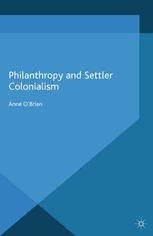
Philanthropy and Settler Colonialism PDF
Preview Philanthropy and Settler Colonialism
Philanthropy and Settler Colonialism Anne O’Brien Philanthropy and Settler Colonialism AlsobyAnneO’Brien POVERTY’SPRISON:ThePoorinNSW,1880–1918 GOD’SWILLINGWORKERS:WomenandReligioninAustralia Philanthropy and Settler Colonialism Anne O’Brien AssociateProfessorofHistory,UniversityofNewSouthWales,Australia ©AnneO’Brien2015 Softcover reprint of the hardcover 1st edition 2015 978-1-137-44049-5 Allrightsreserved.Noreproduction,copyortransmissionofthis publicationmaybemadewithoutwrittenpermission. Noportionofthispublicationmaybereproduced,copiedortransmitted savewithwrittenpermissionorinaccordancewiththeprovisionsofthe Copyright,DesignsandPatentsAct1988,orunderthetermsofanylicence permittinglimitedcopyingissuedbytheCopyrightLicensingAgency, SaffronHouse,6–10KirbyStreet,LondonEC1N8TS. Anypersonwhodoesanyunauthorizedactinrelationtothispublication maybeliabletocriminalprosecutionandcivilclaimsfordamages. Theauthorhasassertedherrighttobeidentifiedastheauthorofthiswork inaccordancewiththeCopyright,DesignsandPatentsAct1988. Firstpublished2015by PALGRAVEMACMILLAN PalgraveMacmillanintheUKisanimprintofMacmillanPublishersLimited, registeredinEngland,companynumber785998,ofHoundmills,Basingstoke, HampshireRG216XS. PalgraveMacmillanintheUSisadivisionofStMartin’sPressLLC, 175FifthAvenue,NewYork,NY10010. PalgraveMacmillanistheglobalacademicimprintoftheabovecompanies andhascompaniesandrepresentativesthroughouttheworld. Palgrave®andMacmillan®areregisteredtrademarksintheUnitedStates, theUnitedKingdom,Europeandothercountries. ISBN 978-1-349-49449-1 ISBN 978-1-137-44050-1 (eBook) DOI 10.1057/9781137440501 Thisbookisprintedonpapersuitableforrecyclingandmadefromfully managedandsustainedforestsources.Logging,pulpingandmanufacturing processesareexpectedtoconformtotheenvironmentalregulationsofthe countryoforigin. AcataloguerecordforthisbookisavailablefromtheBritishLibrary. AcatalogrecordforthisbookisavailablefromtheLibraryofCongress. Contents Acknowledgements vii Introduction 1 1 GoverningandthePhilanthropicDisposition 10 Kindness,mercyandthequestforcolonies 11 ‘Splendidedificesofwhitesquaredstone’:voluntarismand thepenalinstitutions 17 ‘Auniversaldesiretoassist’:philanthropicorganisations 22 Respectabilityandthesegmentationofcharity 26 ‘OneBlood’:blackphilanthropy 28 2 TheDemocraticMoment 36 Fightingpauperisminthefirstdepression 38 CarolineChisholmandworking-classwomen 43 Thealcoholproblem:moralandsocialreform 48 Fightingthedevil:NathanielPidgeon 52 MyallCreekandthelimitsofcompensation 54 3 An‘AgeofPhilanthropy’? 61 Whiterelief:asylums 63 Whiterelief:rations 66 Reformingthefallen 69 Civilisingtheurbanpoor 73 Missionstotheheathen 78 Parallelsanddivergences 82 4 PreventionandProtection 87 Depression 89 Rescue 93 Prevention 97 Humanitarianprotection? 104 5 AHandUp:TheProblemsofIndependence 116 Theshadowofwar 117 Gendertensions 121 Depression 123 Amedicalproblem? 128 v vi Contents Fightingprotection 135 Depressionactivists 139 Missionsandindependence 141 6 BeyondMereWelfare 149 Anewsocialorder 150 Self-helpandwhiterights 155 AdvancingIndigenousrights 157 Assimilation,activismandpracticalhelp 162 Womenandchildren:institutionsinwhiteAustralia 165 Amissiontoeducate 171 7 ‘ToHellwithCharity’ 178 Self-helpandradicalchange 179 Faithincommunity 184 Socialworkandcommunitywork 188 Activismandpracticalhelp 193 Self-determinationandcommunity 199 Epilogue 205 Notes 209 Bibliography 257 Index 286 Acknowledgements The research and writing of this book has been greatly assisted by grants from the Australian Research Council (DP0772656) and the Faculty of Arts and Social Sciences at the University of New South Wales. I am grateful for permission to access material and generous professional assistance from the librarians and archivists at the State Library of New South Wales, the State Library of Victoria, the State Library of Queensland, the State Library of South Australia, the State Library of Tasmania, the National Library of Australia, the UNSWLibrary,theGoodSamaritanArchivesGlebe,theSistersofChar- ityArchivesPottsPoint,theSmithFamilySydneyandtheUniversityof SydneyArchives. WarmthankstomycolleaguesintheSchoolofHumanitiesandLan- guages at UNSW for maintaining a supportive and lively environment inwhichtoteachandresearch.‘TheHistorySeminar’andthesymposia ofthe‘Imperial,ColonialandTransnationalHistoriesResearchCluster’ have provided opportunities for much stimulating discussion. I have also gained a great deal from conferences, seminars and workshops organisedbytheAustralasianWelfareHistoryWorkshopcollective,the AustralianCatholicUniversity,theAustralianHistoricalAssociation,the Indigenous Policy and Dialogues Research Unit at UNSW, Macquarie University,theMenziesCentreatKingsCollegeLondon,UniversityCol- lege Dublin and the University of Melbourne. It has been a pleasure to havesharedmyloveofhistorywitharangeofcommunityorganisations includingtheUnitingChurchHistoricalSociety,theCatholicHistorical Society,theReligiousArchivistsSociety,thePresbyterianFellowship,the MovementfortheOrdinationofWomenandtheBlueMountainsSocial EnquiryCentre. My intellectual debt to the people in the footnotes is enormous. Ifwritingisasolitaryoccupation,itislesssoforhistorianswhoengage with researchers who have gone before. Indeed, it is deeply sustaining toencountertheworkofscholarswhohavebroughtrespectandendless fascinationtotheexplorationofhumanbeingsinthepast.Writingthis bookhasgivenmeanewappreciationoftherichnessofthescholarship towhichitcontributes. SpecialthankstoPatriciaCurthoysformeticulousresearchassistance and unfailing good humour and to Shurlee Swain, who read large vii viii Acknowledgements chunks of the manuscript despite the multiple demands on her time, and made comments of great pertinence. Any blame is all mine, of course. I was very gratefulbe able to call on Charmaine Robson’s com- petence and enthusiasm to teach one of my courses when I took leave to complete this book, and Eureka Henrich and Carlin de Montfort were excellent tutors, freeing me up to write. To the ‘Australianists’ in history at UNSW – Ruth Balint, Lisa Ford, Grace Karskens and Zora Simic–thanksforbeingsuchgoodcolleaguesandforthehardworkthat went into launching Sydney’s Australian Studies Seminar. To my post- graduateresearchstudentsandundergraduatesin‘WinnersandLosers: Poverty,WelfareandSocialJusticeinAustralia’,thanksfortheinsights, questions,argumentsandconversationsovermanyyears.ThankstoJen McCallandHollyTylerofPalgraveMacmillanformakingthejourneyto printsostraightforwardandtoRickBouwmanforcarefulcopy-editing. Thanks most of all to my daughters Lizzie and Katie, who have listened to innumerable stories from this book with good grace and humourandtoJohnIngleson,whohaslistened,read,commentedand otherwiseprovidedunwaveringassistance. Introduction In the last couple of decades, philanthropy has taken off. Offering tax concessions, exposure to markets and scads of social capital, donation has been built into the business models of most large corporations. ‘Ordinarypeople’alsogive–theirmostlikely‘profile’isthatofamiddle- agedwomanwithhigherthanaverageincomeandeducation.1 Butthe useof‘philanthropy’toreferprimarilytocorporateorindividualbene- factionisarelativelyrecentrevival,despitethelonghistoryofgivingin Australia.Indeed,thewordhadlargelyfallenoutofusebythemid-20th century:‘Likecourtlymanners’,itwas‘suspect’,accordingtothePrinci- palofWomen’sCollegeinBrisbanein1951.2Anditwouldseemtohave stayedthatwayuntilthemid-1990s.WhenElizabethCham,Directorof thenewlyenlargedumbrellaorganisationPhilanthropyAustraliastarted in1996tocontactthepresstoraisetheprofileofgiving,shewasadvised tochooseadifferentword.3 Overthenextdecade‘philanthropy’,both the term and the activity, became fashionable – an ‘innovative, grow- ing, influentialand high performingsector’ as PhilanthropyAustralia’s website now describes it.4 Its rise was an international phenomenon, both product and pillar of the revival of the market economy. Given the fulsome tradition of American giving it is not surprising that Bill and Melinda Gates are among its highest-profile global ambassadors, but Australia seeks to foster its own tradition: it seemed only natural whenaMacquariebankerandphilanthropist,forexample,wasnamed ‘AustralianoftheYear’in2011.5 If philanthropy today is mostly associated with giving away money, itsmeaningsatthemomentofAustralia’scolonisationinthelate18th century were broader and richer. It is those meanings this book seeks to trace. But what did it mean then? Literally, of course, it has always referred to a ‘love of humanity’ – like today’s benefactors it sought to 1
